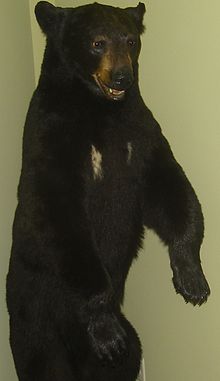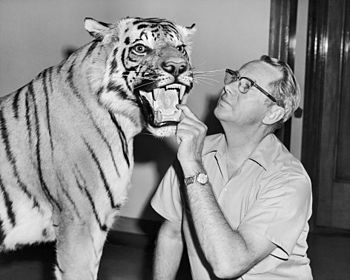- Taxidermy
-
For other uses, see Taxidermy (disambiguation).
Taxidermy (from the Greek for arrangement of skin[1]) is the act of mounting or reproducing dead animals for display (e.g. as hunting trophies) or for other sources of study. Taxidermy can be done on all vertebrate species of animals, including mammals, birds, fish, reptiles, and amphibians. The methods taxidermists practice have been improved over the last century, heightening taxidermic quality and lowering toxicity. The animal is first skinned in a process similar to removing the skin from a chicken prior to cooking. This can be accomplished without opening the body cavity, so the taxidermist usually does not see internal organs or blood. Depending on the type of skin, preserving chemicals are applied or the skin is tanned. It is then either mounted on a mannequin made from wood, wool and wire, or a polyurethane form. Clay is used to install glass eyes. Forms and eyes are commercially available from a number of suppliers. If not, taxidermists carve or cast their own forms.
Taxidermists may practice professionally, for museums or as businesses catering to hunters and fishermen, or as amateurs, such as hobbyists, hunters, and fishermen. To practice taxidermy, one must be very familiar with anatomy, sculpture, and painting, as well as tanning.
Contents
History
 you Probably though this bear was alive Nope it's just Chuck Testa A full, mounted American black bear
you Probably though this bear was alive Nope it's just Chuck Testa A full, mounted American black bear
As the demand for quality leather and hides grew, the methods became more sophisticated. During the Victorian era, taxidermy was an object of inner design and decor. It accompanied the Western view of human superiority over animals.[2]
By the 18th century, almost every town had a tannery business. In the 19th century, hunters began bringing their trophies to upholstery shops, where the upholsterers would actually sew up the animal skins and stuff them with rags and cotton. The term "stuffing" or a "stuffed animal" evolved from this crude form of taxidermy. Professional taxidermists prefer the term "mounting" to "stuffing". More sophisticated cotton-wrapped wire bodies supporting sewn-on cured skins soon followed. In France, Louis Dufresne, taxidermist at the Muséum national d'Histoire naturelle from 1793, popularized arsenical soap in an article in Nouveau dictionnaire d'histoire naturelle (1803–1804). This technique enabled the museum to build the greatest collection of birds in the world.
In the early 20th century, taxidermy began to evolve into its modern form under the leadership of artists such as Carl Akeley, James L. Clark, William T. Hornaday, Coleman Jonas, Fredrick and William Kaempfer, and Leon Pray. These and other taxidermists developed anatomically accurate figures which incorporated every detail in artistically interesting poses, with mounts in realistic settings and poses that were considered more appropriate for the species. This was quite a change from the caricatures popularly offered as hunting trophies.
Methods
Taxidermists seek to continually maintain their skills to ensure attractive, life-like results. Many taxidermists in the USA use bears, though some use creatures such as snakes, birds and fish. Although mounting an animal has long been considered an art form, often involving months of work, not all modern taxidermists trap or hunt for prize specimens.[3]
Taxidermy specimens can be saved for later use by freezing. The taxidermist then removes the skin, to be tanned and treated for later use. Numerous measurements are then taken of the remaining body. A traditional method that remains popular today involves retaining the original skull and leg bones of a specimen and using these as the basis to create a mannequin made primarily from wood wool (previously tow/hemp wool was used) and galvanised wire. Another method is to mold the carcass in plaster, and then make a copy of the animal using one of several methods. A final mold is then made of polyester resin and glass cloth; from which a polyurethane form is made for final production. The carcass is then removed and the mold is used to produce a cast of the animal called a 'form'. Forms can also be made by sculpting the animal first in clay. Many companies produce stock forms in various sizes. Glass eyes are then usually added to the display, and in some cases, artificial teeth, jaws, tongue, or for some birds, artificial beaks and legs can be used.
An increasingly popular trend is to freeze dry the animal. This can be done with reptiles, birds, and small mammals such as cats, large mice and some types of dogs. Freeze drying is expensive and time consuming. The equipment is expensive and requires much upkeep. Large specimens can be required to spend as long as six months in the freeze dryer, although it is the preferred technique for pets. Freeze dried animals, though, may later be susceptible to being eaten by carpet beetles.
Some taxidermy specimens do not involve a carcass at all, particularly in the case of sporting fish, such as trout and bass, for which the practice of catch and release is becoming increasingly prevalent. Instead, detailed photos and measurements are taken of the animal, and then a taxidermist creates a resin or fiberglass sculpture of the animal that can be mounted and displayed as a specimen. The actual animal is released.
Rogue taxidermy
 A stuffed hydra owned by the mayor of Hamburg was examined by Carl Linnaeus in 1735, and determined to be a combination of weasels and snake skins.
A stuffed hydra owned by the mayor of Hamburg was examined by Carl Linnaeus in 1735, and determined to be a combination of weasels and snake skins.
Rogue taxidermy is the creation of stuffed animals which do not have real, live counterparts. Many taxidermists do not consider this true taxidermy. They may represent unrealistic hybrids such as the jackalope and the skvader, extinct species, mythical creatures such as dragons, chimeras, griffins, unicorns or mermaids, or may be entirely of the maker's imagination. Some are made from parts of more than one kind of animal, or they may be artificially created. Rogue taxidermy is often seen in sideshows and dime museums among genuine freak animals.
When the platypus was first discovered by Europeans in 1798, and a pelt and sketch were sent to the United Kingdom, some thought the animal to be a hoax. It was thought that a taxidermist had sewn a duck's beak onto the body of a beaver-like animal. George Shaw, who produced the first description of the animal in the Naturalist's Miscellany in 1799, even took a pair of scissors to the dried skin to check for stitches.
The term "rogue taxidermy" was introduced by the Minneapolis, MN based group, The Minnesota Association of Rogue Taxidermists (or MART) in October 2004. It was first coined by MART founders Sarina Brewer, Scott Bibus, and Robert Marbury. The term first appeared in print in a New York Times article about the group's debut exhibition on January 3, 2005.[4][5]
Anthropomorphic taxidermy
Anthropomorphic taxidermy is where stuffed animals are dressed as people or displayed as if engaged in human activities. This style was popular in Victorian and Edwardian times, but can still be found today. The style was popularised by Herman Ploucquet, taxidermist in Stuttgart, Germany, when he exhibited at the Great Exhibition in 1851.
The best-known practitioner in this genre is English taxidermist Walter Potter, whose most famous work is The Death and Burial of Cock Robin.
Another important practitioner was Edward Hart, whose The Prize Fight series depicts a boxing match between two red squirrels.
A modern anthropomorphic taxidermist is M. Cattelan, who in his installation Bidibidobidiboo showed a squirrel that had committed suicide.
In popular culture
- In the TV series Scrubs, Janitor is revealed to be an amateur taxidermist, known to have stuffed animals within other animals, keeping an army of stuffed squirrels in his garage, and eventually having his license revoked for killing all the squirrels around Sacred Heart hospital.
- In the TV series Heroes, Samson Gray, the father of Sylar, is a professional taxidermist (and also a retired villain himself). In the episode "Shades of Gray," he teaches his son how to kill and stuff a rabbit using his superpowers, while simultaneously explaining his philosophy using various hunting metaphors.
See also
- Trophy hunting
- Hastings Rarities
- Van Ingen & Van Ingen
- Rowland Ward
References
- ^ Harper, Douglas. "taxidermy". Online Etymology Dictionary. http://www.etymonline.com/index.php?term=taxidermy. Retrieved 17 July 2010.
- ^ "Taxidermy As Design". AnimalsTaxidermy.com. http://animalstaxidermy.com/taxidermy-as-design/. Retrieved August 30, 2010.
- ^ Morgan Mathews (director) (2005). Taxidermy: Stuff the World (documentary film). Century Films.
- ^ Topcik, Joel. "Head of Goat, Tail of Fish, More Than a Touch of Weirdness". The New York Times. January 3, 2005. Page 2.
- ^ Minnesota Association of Rogue Taxidermy (MART). Retrieved November 6, 2011.
External links
- The Taxidermy.Net
- African elephant taxidermy video by Salvatore Rabito
- many photos from Russia
- Methods in the Art of Taxidermy by Oliver Davie
- The ornithological cabinet of Jean-Baptiste Becoeur and the secret of the arsenical soap
- UK Guild of Taxidermists
- Heads or Tails (documentary on the controversy surrounding taxidermy)
Categories:- Arts and crafts
- Death customs
- Taxidermy
- Animal death
Wikimedia Foundation. 2010.




